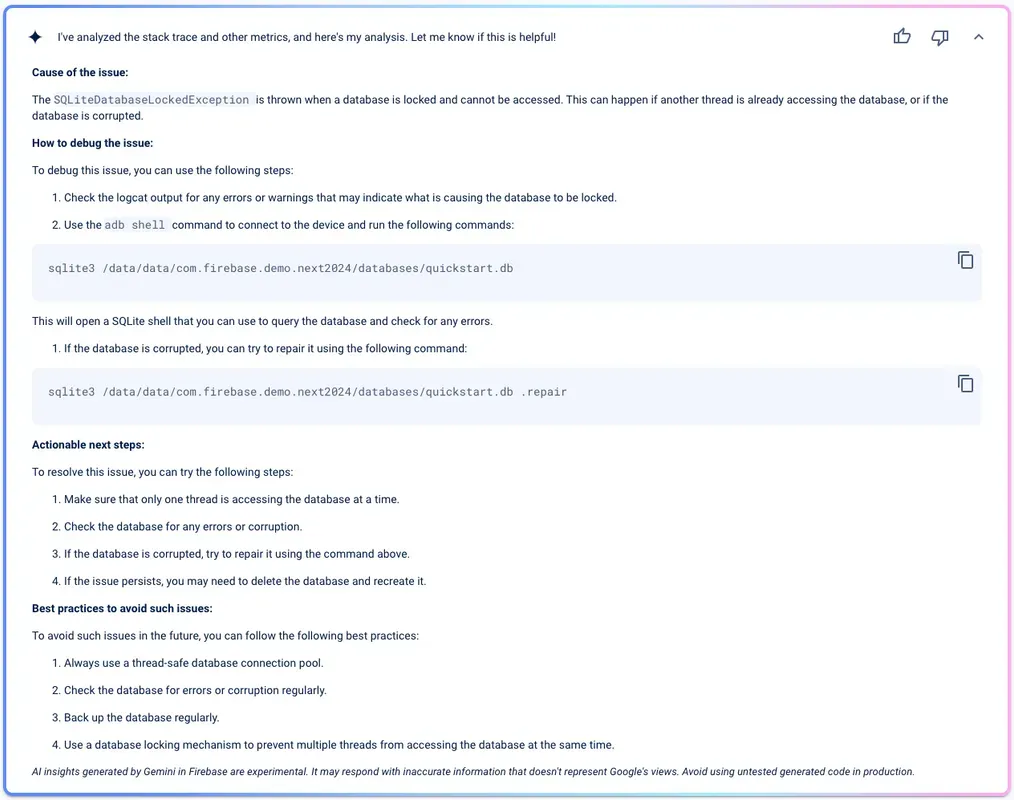Diagnosing, troubleshooting, and solving app issues are some of the most time consuming (not to mention annoying!) parts of app development. Unfortunately, you can’t have someone pair programming with you to diagnose issues all the time, but we’re hoping that the latest feature from Crashlytics is a good substitute…at least until society figures out the whole cloning thing.
Introducing AI Assistance in Crashlytics, Firebase’s latest troubleshooting tool aimed at speeding up the time it takes you to understand why a crash happened and what to do about it. Combining the power of the Gemini model and Firebase’s wealth of mobile app development knowledge, Crashlytics can now analyze the issues from your app and provide actionable, AI-powered insights to help get to a root cause.
This feature is already available in the Crashlytics dashboard for your Apple and Android apps, as a part of the broader Gemini in Firebase offering. From the Crashlytics dashboard, click into an issue to view its details page. AI Assistance will be front and center in the new “Insights” section — you can’t miss it. Note that to generate these insights, you need to be an owner, editor, or Cloud AI Companion user in the Firebase project as well as accept the Gemini terms of service.
What kind of assistance can you get?
These insights can leverage stack trace and variants information, trends in your data (like custom keys), as well as the power of the Gemini model. In fact, the Gemini model itself contributes to the decision of what types of information would be most helpful to use, and also what types of assistive information would be best to provide.
Our aim is to provide as many of the following categories of information as possible:
-
Cause of the issue: A concise, but information-rich explanation of the error and the most common causes. This information is as human-readable as possible so that anyone on your team can quickly understand what’s happening — or not happening.
-
How to debug the issue: The Gemini model will offer a few potential ways to either reproduce the error or dig deeper to find the root cause. Sometimes this even includes recommended commands to try or code to use (with caution of course!).
-
Actionable next steps: The Gemini model will use Firebase’s wealth of knowledge on mobile app development to recommend a few potential resolution paths whenever possible. Whether it’s helping you grow your knowledge base on how to address different crash types or highlighting an approach you might not have initially thought of, we’re hoping these serve as a kickstart to your triage process.
-
Best practices to avoid such issues: Part of the troubleshooting process is, ideally, future-proofing your code so these types of issues don’t bubble up again. The Gemini model does its best to scour thousands of pages of developer documentation (and more) to provide you with ways to keep this issue closed.

Try AI Assistance in Crashlytics today! Get started by visiting an issue’s detail page in the Crashlytics dashboard.
Gemini (and the entire Firebase team) is always learning, and your feedback is a vital part of that process. We look forward to hearing from you and learning how you’re incorporating Gemini into your crash triage workflow!
